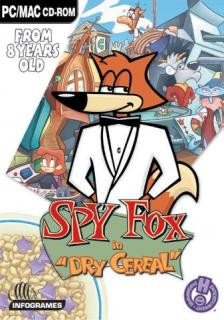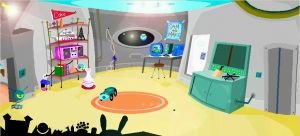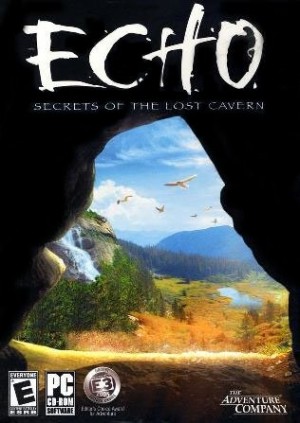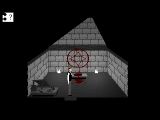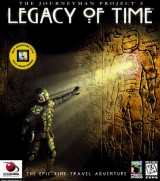Review for Spy Fox in ‘Dry Cereal’
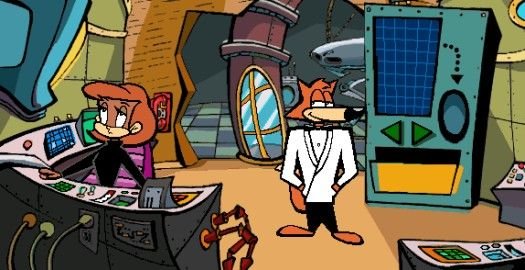
Game information
Many of us have childhood memories of adventure games, but lots of those games weren’t actually made for kids. Some of the jokes may have passed us by, and you may remember getting frustrated by not being able to solve a puzzle. Spy Fox in 'Dry Cereal', a game produced over a decade ago by Humongous Entertainment (co-founded by Monkey Island’s Ron Gilbert) and recently ported to the Nintendo Wii, is just such a junior adventure designed specifically for children. The Spy Fox franchise was Humongous’ most advanced (with Putt-Putt, Freddi Fish and Pajama Sam aimed at even younger audiences), targeting children eight and up, but in reality it can be enjoyed by anyone as young as six. The series spanned three adventure titles in total, beginning with Dry Cereal, a humourous and engaging experience which is bursting with charm.
Taking centre stage is the game’s namesake, Spy Fox, a suave, anthropomorphic – you guessed it – fox, who begins his story on a plane, receiving a message from his co-worker Monkey Penny via the in-flight meal. Yes, you read that right. He learns that the evil William the Kid has captured all of the world’s dairy cows and plans to replace their milk with the goat alternative. Kid has created a Milky Weapon of Destruction to flood the world with dairy milk so that the cows suffer the blame and are locked away. It’s a suitably wacky plot that lets you know straight away that this will be an offbeat experience, despite clearly being influenced by other popular spy stories from James Bond to Mission: Impossible.
Flying over Spy Fox’s destination, a Greek island named Acidophilus, he abruptly ejects himself from his seat and begins to plummet towards the ground. This action basically acts as a very brief tutorial, with Spy Fox opening his inventory and inviting the player to pick a gadget to help him land safely. If nothing is selected after a time, the game automatically picks one for you. Not only does this introduce children to the point-and-click control scheme, but also makes them aware of time limits that come into play further on.
In the original PC version (on which this review is based), one click from the mouse enables all the commands possible. There is no complicated verb selection, and the game decides how Spy Fox is going to react to something, whether that is talking to a character, picking something up or simply providing a witty one-liner. Rather than seeing important items lying around in the open for later use, objects are obtained through plot-progressing devices such as solving puzzles or the gadget vending machine at the secret spy headquarters. As the fox says himself, “a spy without a gadget is like a shopping cart without a broken wheel.”
The zany Professor Quack rustles up six inventions for the vendor, which vary from putty to night-vision shoes, of which Spy Fox can store a total of four at a time. Once you’ve begun exploring, it’s often glaringly obvious what you should be taking from the machine, such as the safe cracker for opening a safe or suction cufflinks to move across a wall. However, players can return to replace their selections if they haven’t chosen the correct ones, so even if you’re not sure what gadget you should be using, a small spout of trial and error will quickly see you along the way. The restriction simply encourages some thought as to what you should be taking. Unfortunately, this simplistic approach puts most of the puzzle-solving items all in one place, removing some of the sense of personal discovery.
Apart from using your spy tools, interacting with the world directly yields most of the solutions to the problems you’ll encounter. Spy Fox’s first task is to rescue Mr. Udderly from the Feta Cheese Factory, getting his rump roast down from where it’s tied up over a pool of piranha. The solution lies in fiddling with the temperature controls on the tank and paying close attention to what happens when you do so. Very rarely do you actually ‘use’ a collected item on something. Puzzles involving timing and memory (from the clues you’ve gathered) are the norm, such as planting a device on someone when they look away or remembering the combination for a dial.
While less traditional for an adventure game, this approach makes you feel more like a spy living an on-the-edge lifestyle. Although you cannot fail your mission, and you get a second shot at everything that doesn’t quite work out the first time, the atmosphere builds tension while still retaining a lighthearted feel. Talking to someone adds their face to your inventory, allowing Spy Fox to question people about that person specifically and discover what they might be hiding from you. You’re collecting details, sneaking around and learning information from everyone that surrounds you. It’s a classic spy experience that’ll live up to children’s imaginations.
The universe isn’t as serious as that of 007’s, however. Although there are a few cheeky nods to any adults that happen to be listening in (or playing themselves under the pretense of checking it out first, and I guarantee some will), most of the jokes consist of groan-worthy puns from Spy Fox himself. These cheesy lines will amuse the kids who are playing it, and they are backed up by visual gags that come from interacting with the environment, like a pelican in the island square who constantly changes his tattoo or seeing what lurks behind and within all the nooks and crannies. There are a lot of non-essential rewards for clicking everything, and you’re often shown a humourous animation rather than hear a line of descriptive dialogue that you might get in a standard adult adventure, an approach that makes the game world feel visually alive through both the characters and their surroundings.
Once Spy Fox arrives at a scene, he will remain in one spot until you click on a hotspot to have him interact with it. Players do not move him freely around the room, as his position is predetermined. Moving your cursor over a door or the side of the screen will turn it into a large arrow to signify the exit, and clicking that causes Spy Fox to zoom over and go through. This slightly detracts from the connectivity with the character, as you don't have full control over him, instead taking a backseat from the action. It doesn’t impact the gameplay itself in any way, however, and may not even faze children, especially since none of the rooms scroll.
One descriptive word that is key to Dry Cereal is “variation”. The game is split into three segments, each having their own selection of different elements that are randomly assigned whenever you begin a new game for a unique experience each time. There are two possible routes to discovering William the Kid’s hideout, three potential items that Spy Fox can find to defeat Kid, and two rooms that may act as the final layer of defense for his headquarters. In the main story path, you could find yourself cruising out to sea and infiltrating the enemy via underwater routes, or instead racing across the island of Acidophilus uncovering Greek ruins. Both have the same goal, but simply act as a different way of achieving it. Even then, in one game Spy Fox could find himself searching for a punchcard and learning the art of Cock-a-Doodle Fu, while in another he could be seeking a diode and taming alligators.
This randomness definitely adds a great degree of replayability, and you're going to have to play through the game a few times to see everything it has to offer, though you’re likely to encounter some repetition in each. It also impacts the length of the game; a single playthrough should clock in around three hours at most. The alternate content adds about four hours to that, although that depends on how confident the player is with adventures. Replaying the game may sound tedious for older players, but for the younger ones, the simple joy of revisiting the exciting world of Spy Fox and taking him on different adventures will definitely entertain at least a few times through.
And the world of Spy Fox is certainly one that you'll enjoy being in. Bright, lavish visuals are the order of the day, with a generally simple artistic style that injects some complexity through oddly-shaped set pieces and colours that openly exceed their borders. Doors career off at weird angles, windows vary wildly in size and walls are patched up for seemingly no reason. At the beginning of the game you’ll be surrounded by volcanoes and Roman buildings, but later you’ll explore mechanical locations full of pipes and levers as you get nearer to the secret fortress. There are no humans to be found anywhere, and all the animals that inhabit the island fit in perfectly. Each one has wonderfully accentuated characteristics such as the zaniness of Professor Quack, with his lisp and tendency to eat blueprints, or the mystique of Russian Blue, a seductive but secretive cat. As for the main fox himself, wearing a white tux, black trousers and no shoes, Spy Fox represents sophistication, slyness and charm while still maintaining his cheekiness with a constant smile, smartly-styled hair and a particularly long snout. He makes a wisecrack whenever he can and charismatically occupies the screen with his pleasant and refined look.
These personalities are expertly portrayed through the actors, who each offer a distinct and memorable voice with a perfect delivery that breathes humour into each line. You’ll recall Spy Fox’s smooth-sounding tones long after you’ve finished playing. The music isn’t as memorable, as it’s often short, resulting in a constant loop of very similar sounding tunes. However, the sound effects add more interest with cartoonish whooshes and bangs. It’s all very comparable to a TV cartoon, and you could easily imagine the game transitioning itself well to that medium.
Alongside the main storyline, there are some other distractions such as a game of Go Fish. While not necessarily a compulsory part of the plot path, you can always challenge the portly Mr. Big Pig for a bit of light relief. Despite being a simplistic card game at heart, it is still very enjoyable to play and see your opponent's sudden change of tone and body temperature (sweat drips down his head) as your card stack gets higher and higher. Via his Spy Watch, Spy Fox can also access Happy Fun Sub, a side-scrolling game in which the player destroys satellites, buoys, and submersibles in the Spycraft. It has no relevance to the overall game, and is simply there to act as a time waster or a break. It's nothing substantial, and certainly doesn't compete with Go Fish as a worthwhile diversion.
While Spy Fox in 'Dry Cereal' isn't going to provide a deep challenge for experienced gamers, the ‘junior adventurers’ are going to have a blast in what is sure to be a memorable experience. The colourful and wacky world is brought to life through the TV cartoon-quality visuals and voices, and the diverse personalities and snappy dialogue will undoubtedly provide laughs for all who have the pleasure of playing it. It’s most definitely for the younger ones, and perhaps a bit too streamlined even then, but the first adventure of Spy Fox will have the kids coming back again and again for additional helpings of whimsical delight.


